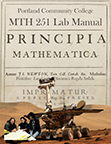Activity 2.3 Indeterminate Limits
¶Many limits have the form \(\frac{0}{0}\) which means the expressions in both the numerator and denominator limit to zero (e.g.\(\lim\limits_{x\to3}\frac{2x-6}{x-3}\)). The form \(\frac{0}{0}\) is called indeterminate because we do not know the value of the limit (or even if it exists) so long as the limit has that form. When confronted with limits of form \(\frac{0}{0}\) we must first manipulate the expression so that common factors causing the zeros in the numerator and denominator are isolated. Limit law A7 can then be used to justify eliminating the common factors and once they are gone we may proceed with the application of the remaining limit laws. Examples 2.3.1 and 2.3.2 illustrate this situation.
Example 2.3.1.
Note that the forms of the limits on either side of the first line are \(\frac{0}{0}\text{,}\) but the form of the limit in the second line is no longer indeterminate. So at the second line, we can begin applying limit laws.
Example 2.3.2.
The form of each limit above was \(\frac{0}{0}\) until the fourth line, where we were able to begin applying limit laws.
As seen in Example 2.3.2, trigonometric identities can come into play while trying to eliminate the form \(\frac{0}{0}\text{.}\) Elementary rules of logarithms can also play a role in this process. Before you begin evaluating limits whose initial form is \(\frac{0}{0}\text{,}\) you need to make sure that you recall some of these basic rules. That is the purpose of Exercise 2.3.1.
Subsection Exercises
1.
Complete each of the following identities (over the real numbers). Make sure that you check with your lecture instructor so that you know which of these identities you are expected to memorize.
The following identities are valid for all values of \(x\) and \(y\text{.}\)
There are three versions of the following identity; write them all.
The following identities are valid for all positive values of \(x\) and \(y\) and all values of \(n\text{.}\)
Use the limit laws to establish the value of each of the following limits after first manipulating the expression so that it no longer has form \(\frac{0}{0}\text{.}\) Make sure that you use the step-by-step, vertical format shown in Examples 2.3.1 and Example 2.3.2. Make sure that you cite each limit law used.
2.
\(\lim\limits_{x\to-4}\dfrac{x+4}{2x^2+5x-12}\)
3.
\(\lim\limits_{x\to0}\dfrac{\fe{\sin}{2x}}{\fe{\sin}{x}}\)
4.
\(\lim\limits_{\beta\to0}\dfrac{\fe{\sin}{\beta+\pi}}{\fe{\sin}{\beta}}\)
5.
\(\lim\limits_{t\to0}\dfrac{\fe{\cos}{2t}-1}{\fe{\cos}{t}-1}\)
6.
\(\lim\limits_{x\to1}\dfrac{4\fe{\ln}{x}+2\fe{\ln}{x^3}}{\fe{\ln}{x}-\fe{\ln}{\sqrt{x}}}\)
7.
\(\lim\limits_{w\to9}\dfrac{9-w}{\sqrt{w}-3}\)
